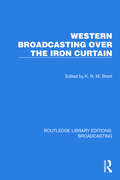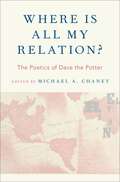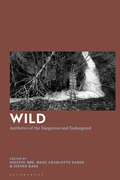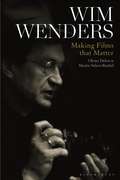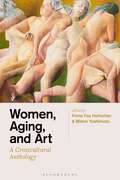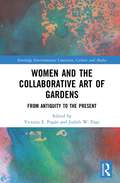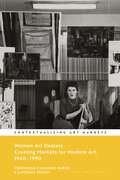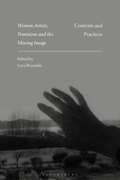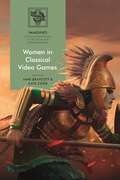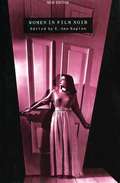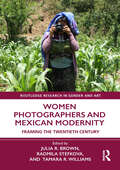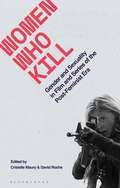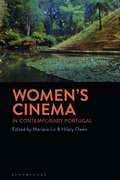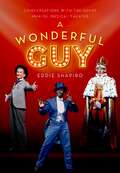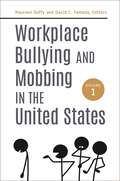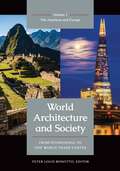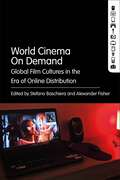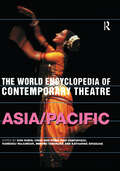- Table View
- List View
Western Broadcasting over the Iron Curtain (Routledge Library Editions: Broadcasting #38)
Western Broadcasting Over the Iron Curtain (1986) examines the development of broadcasting policy by Western democracies, levels of government control of policy, efforts by communist regimes to minimize the effects of western broadcasting, and Soviet and Eastern European audience opinions on such diverse subjects as the success or failure of socialism and the Korean airline disaster.
Where Is All My Relation?: The Poetics of Dave the Potter
Where Is All My Relation? presents the first sustained academic discussion of the poetry, pottery, and culture of David Drake, an antebellum slave who distinguished himself by composing verse on the ceramics he produced in the years leading up to the Civil War. During the 1830s, 40s, and 50s, he incised couplets and signatures (a singular "Dave") onto the incredibly large storage vessels that he made. In fact, his stoneware pots and jars are among the largest made in North America during the antebellum era, and craft enthusiasts and appraisers are still proclaiming their precision and ambitious volume. Rich with biblical allusions, historical facts, and personal opinions, his art provides unique insights into the lives of slaves, craftsmen, and the culture of the American South in the first half of the nineteenth century. The essays here engage with the historical context and major issues that Drake's work provokes, among them: prohibitions against slave literacy; Drake's privileged status compared to other slaves at the time; the interpretive status of his material craft objects; the influence of contemporary African American poet George Moses Horton; and Drake's ability to sell his pottery despite the fact that slaves were not officially permitted to participate in a cash economy. Featuring essays by literary critics, art-historians, archaeologists, and curators, Where Is All My Relation? provides a window into the world of nineteenth century material culture and expands our traditional understanding of the slave-narrative genre.
Where Words and Images Meet
Bringing together a fascinatingly diverse yet closely related group of subjects, Where Words and Images Meet asks us to rethink what we know about words and images and how they interact. From 19th-century frontispieces to Soviet photo albums, from the relationships between portraits and biographies to museum labels, the book's richly illustrated chapters open up historically specific connections between word and image to collective examination and fruitful analysis. Written by both established and emerging scholars in a range of interrelated fields, the chapters deliberately foreground previously overlooked topics as well as unfamiliar disciplinary approaches, to offer a stimulating and carefully developed framework for looking at these ubiquitous phenomena afresh. Where Words and Images Meet opens up for analysis and reflection the forms of attention, practices, skills and assumptions that underlie visual interpretation and meaning-making in the writing of history. By bringing the features of the materials we read and look at into focus, we can grasp more effectively the complex interrelationships involved, and enhance our practice and understanding.
The White Tower at the Tower of London (Large Print)
This picture shows the White Tower which is part of the group of buildings collectively known as the Tower of London. There is a locator dot shown, which will be at the top left of the page when the image is the right way up. At the top of the page, on the left and right, are the tops of two of the four corner towers with small windows immediately below them: four on the left and one on the right. In the centre of the page is the castellated top of the building. Below this are three rows of windows with four buttresses running vertically between them. In the bottom left of the page is an arched doorway with stairs leading to the right, down to ground level.
The White Tower at the Tower of London (UEB Contracted)
This picture shows the White Tower which is part of the group of buildings collectively known as the Tower of London. There is a locator dot shown, which will be at the top left of the page when the image is the right way up. At the top of the page, on the left and right, are the tops of two of the four corner towers with small windows immediately below them: four on the left and one on the right. In the centre of the page is the castellated top of the building. Below this are three rows of windows with four buttresses running vertically between them. In the bottom left of the page is an arched doorway with stairs leading to the right, down to ground level.
The White Tower at the Tower of London (UEB Uncontracted)
This picture shows the White Tower which is part of the group of buildings collectively known as the Tower of London. There is a locator dot shown, which will be at the top left of the page when the image is the right way up. At the top of the page, on the left and right, are the tops of two of the four corner towers with small windows immediately below them: four on the left and one on the right. In the centre of the page is the castellated top of the building. Below this are three rows of windows with four buttresses running vertically between them. In the bottom left of the page is an arched doorway with stairs leading to the right, down to ground level.
Whose Heritage?: Challenging Race and Identity in Stuart Hall’s Post-nation Britain
This edited collection challenges and re-imagines what is ‘heritage’ in Britain as a globalised, vernacular, cosmopolitan ‘post-nation’. It takes its inspiration from the foundational work of public intellectual Stuart Hall (1932–2014). Hall was instrumental in calling out embedded elitist conceptions of ‘The Heritage’ of Britain. The book’s authors challenge us to reconsider what is valued about Britain’s past, its culture and its citizens. Populist discourses around the world, including Brexit and ‘culture war’ declarations in the UK, demonstrate how heritage and ideas of the past are mobilised in racist politics. The multidisciplinary chapters of this book offer critical inspections of these politics and dig deeply into the problems of theory, policy and practice in today’s academia, society and heritage sector. The volume challenges the lack of action since Hall rebuked ‘The Heritage’ twenty years ago. The authors featured here are predominantly Black Britons, academics and practitioners engaged in culture and heritage, spurred by the killing of George Floyd and the rise of the Black Lives Matter movement to contest racist practices and structures that support them. This fact alone makes the volume a unique addition to the Routledge Museum & Heritage Studies repertoire. The primary audience will be academics, but it will also attract culture sector practitioners and heritage institutions. However, the book is particularly aimed at scholars and community members who identify as Black and are centrally concerned with questions of identity and race in British society. Its Open Access status will facilitate access to the book by all groups in society.
Why We Watch: The Attractions of Violent Entertainment
America is fascinated by violence--where it comes from in ourselves, how it spreads through society, what effect it has on younger generations, and how it looks, in all its chilling and sanguine detail. This arresting collection of essays examines numerous facets of violence in contemporary American culture, ranging across literature, film, philosophy, religion, fairy tales, video games, children's toys, photojournalism, and sports. Lively and jargon-free, Why We Watch is the first book to offer a careful look at why we are drawn to depictions of violence and why there is so large a market for violent entertainment. The distinguished contributors, hailing from fields such as anthropology, history, literary theory, psychology, communications, and film criticism, include Allen Guttmann, Vicki Goldberg, Maria Tatar, Joanne Cantor, J. Hoberman, Clark McCauley, Maurice Bloch, Dolf Zillmann, and the volume's editor, Jeffery Goldstein. Together, while acknowledging that violent imagery has saturated western cultures for millennia, they aim to define what is distinctive about America's contemporary culture of violence. Clear, accessible and timely, this is a book for all concerned with the multiple points of access to violent representation in 1990s America.
Wild: Aesthetics of the Dangerous and Endangered
In this interdisciplinary work, philosophers from different specialisms connect with the notion of the wild today and interrogate how it is mediated through the culture of the Anthropocene. They make use of empirical material like specific artworks, films and other cultural works related to the term 'wild' to consider the aesthetic experience of nature, focusing on the untamed, the boundless, the unwieldy, or the unpredictable; in other words, aspects of nature that are mediated by culture. This book maps out the wide range of ways in which we experience the wildness of nature aesthetically, relating both to immediate experience as well as to experience mediated through cultural expression. A variety of subjects are relevant in this context, including aesthetics, art history, theology, human geography, film studies, and architecture. A theme that is pursued throughout the book is the wild in connection with ecology and its experience of nature as both a constructive and destructive force.
Wim Wenders: Making Films that Matter
Wim Wenders: Making Films That Matter is the first book in 15 years to take a comprehensive look at Wim Wenders's extensive filmography. In addition to offering new insights into his cult masterpieces, the 10 essays in this volume highlight the thematic and aesthetic continuities between his early films and his latest productions. Wenders's films have much to contribute to current conversations on intermediality, whether it be through his adaptations of important literary works or his filmic reinventions of famous paintings by Edward Hopper or Andrew Wyeth. Wenders has also positioned himself as a decidedly transnational and translingual filmmaker taking on the challenge of representing peripheral spaces without falling into the trap of a neo-colonial gaze. Making Films That Matter argues that Wenders remains a true innovator in both his experiments in 3D filmmaking and his attempts to define a visual poetics of peace.
With Fists Raised: Radical Art, Contemporary Activism, and the Iconoclasm of the Black Arts Movement
There are deep black nationalist roots for many of the images and ideologies of contemporary racial justice efforts. This collection reconsiders the Black Aesthetic and the revolutionary art of the Black Arts Movement (BAM), forging connections between the recent past and contemporary social justice activism. Focusing on black literary and visual art of the Black Arts Movement, this collection highlights artists whose work diverged from narrow definitions of the Black Aesthetic and black nationalism. Adding to the reanimation of discourses surrounding BAM, this collection comes at a time when today’s racial justice efforts are mining earlier eras for their iconography, ideology, and implementation. As numerous contemporary activists ground their work in the legacies of mid-twentieth century activism and adopt many of the grassroots techniques it fostered, this collection remembers and re-envisions the art that both supported and shaped that earlier era. It furthers contemporary conversations by exploring BAM’s implications for cultural and literary studies and its legacy for current social justice work and the multiple arts that support it.
Women, Aging, and Art: A Crosscultural Anthology
What images come to mind with the words “women”, “aging”, “old”, even “elderly”? Are they stereotypes? Are there anypositive associations? The thirteen contributions to this edited volume explore a broad range of images of old women, ranging from medieval “old wives” to contemporary re-imaginations of shamans and witches and empowering self-portraits. Works from medieval Europe to colonialtime Polynesia, present West Africa, Japan, and the Americas, in a multiplicity of media are explored in detail. These studies of varied representations of “old women” offer fresh perspectives and an engaging dialogue about society's values and preconceptions regarding the wisdom of our elders and the “golden years” in different times and cultures.
Women and the Collaborative Art of Gardens: From Antiquity to the Present (Routledge Environmental Literature, Culture and Media)
Women and the Collaborative Art of Gardens explores the garden and its agency in the history of the built and natural environments, as evidenced in landscape architecture, literature, art, archaeology, history, photography, and film. Throughout the book, each chapter centers the act of collaboration, from garden clubs of the early twentieth century as powerful models of women’s leadership, to the more intimate partnerships between family members, to the delicate relationship between artist and subject. Women emerge in every chapter, whether as gardeners, designers, owners, writers, illustrators, photographers, filmmakers, or subjects, but the contributors to this dynamic collection unseat common assumptions about the role of women in gardens to make manifest the significant ways in which women write themselves into the accounts of garden design, practice, and history. The book reveals the power of gardens to shape human existence, even as humans shape gardens and their representations in a variety of media, including brilliantly illuminated manuscripts, intricately carved architectural spaces, wall paintings, black and white photographs, and wood cuts. Ultimately, the volume reveals that gardens are best apprehended when understood as products of collaboration. The book will be of interest to scholars and students of gardens and culture, ancient Rome, art history, British literature, medieval France, film studies, women’s studies, photography, African American Studies, and landscape architecture.
Women Art Dealers: Creating Markets for Modern Art, 1940–1990 (Contextualizing Art Markets)
Women Art Dealers brings together fascinating case studies of galleries run by women between the 1940s and 1980s. It marks a departure from other work in the field of art markets, challenging male-dominated histories by analyzing the work of female dealers who anticipated the global model, worked to promote art across continents, and thus developed an international art market. Part 1 focuses on the women gallerists behind the promotion of modern art after World War II who participated in important research about the neo-Avant-Garde. Part 2 examines the contributions by women art dealers toward the birth of new markets – through establishing the reputation of artistic genres, such as video art and photography, and working at the forefront of advancing contemporary art. Finally, Part 3 analyzes case studies from the southern European art scene, paying fresh attention to several under-researched markets in the region like Italy and Portugal. Each chapter study provides a historiographic profile of the gallery under discussion and critical analysis is supported with a wide range of visual material including portraits of the women art dealers, photographs of the exhibitions they managed, and printed documentation like catalogues, invitations, and posters that were often used to support artists on display in experimental ways.
Women Artists, Feminism and the Moving Image: Contexts and Practices
What is the significance of gendered identification in relation to artists' moving image? How do women artists grapple with the interlinked narratives of gender discrimination and gender identity in their work? In this groundbreaking book, a diverse range of leading scholars, activists, archivists and artists explore the histories, practices and concerns of women making film and video across the world, from the pioneering German animator Lotte Reiniger, to the influential African American filmmaker Julie Dash and the provocative Scottish contemporary artist Rachel Maclean. Opening with a foreword from the film theorist Laura Mulvey and a poem by the artist film-maker Lis Rhodes, Women Artists, Feminism and the Moving Image traces the legacies of early feminist interventions into the moving image and the ways in which these have been re-configured in the very different context of today. Reflecting and building upon the practices of recuperation that continue to play a vital role in feminist art practice and scholarship, essays discuss topics such as how multiculturalism is linked to experimental and activist film history, the function and nature of the essay film, feminist curatorial practices and much more. This book transports the reader across diverse cultural contexts and geographical contours, addressing complex narratives of subjectivity, representation and labour, while juxtaposing cultures of film, video and visual arts practice often held apart. As the editor, Lucy Reynolds, argues: it is at the point where art, moving image and feminist discourse converge that a rich and dynamic intersection of dialogue and exchange opens up, bringing to attention practices which might fall outside their separate spheres, and offering fresh perspectives and insights on those already established in its histories and canons.
Women in Classical Video Games (IMAGINES – Classical Receptions in the Visual and Performing Arts)
Despite the prevalence of video games set in or inspired by classical antiquity, the medium has to date remained markedly understudied in the disciplines of classics and ancient history, with the role of women in these video games especially neglected. Women in Classical Video Games seeks to address this imbalance as the first book-length work of scholarship to examine the depiction of women in video games set in classical antiquity. The volume surveys the history of women in these games and the range of figures presented from the 1980s to the modern day, alongside discussion of issues such as historical accuracy, authenticity, gender, sexuality, monstrosity, hegemony, race and ethnicity, and the use of tropes. A wide range of games of different types and modes are discussed, with particular attention paid to the Assassin's Creed franchise's 21st-century ventures into classical antiquity (first in Origins (2017), set in Hellenistic Egypt, and then in Odyssey (2018), set in classical Greece), which have caught the imagination not only of gamers, but also of academics, especially in relation to their accompanying educational Discovery Modes. The detailed case studies presented here form a compelling case for the indispensability of the medium to both reception studies and gender studies, and offer nuanced answers to such questions as how and why women are portrayed in the ways that they are.
Women in Film Noir
The first edition of 'Women in Film Noir' (1978) assembled a group of scholars and critics committed to understanding the cinema in terms of gender, sexuality, politics, psychoanalysis and semiotics. This edition is expanded to include further essays which reflect the renewed interest in Film Noir. Exploring 'neo-noir', postmodernism and other contemporary trends, new essays offer readings of, among others, 'Bound' and 'Basic Instinct', broadening the scope of the book to include questions of race and homosexuality.
Women Photographers and Mexican Modernity: Framing the Twentieth Century (Routledge Research in Gender and Art)
The photographers discussed in this book probe the most contentious aspects of social organization in Mexico, questioning what it means to belong, to be Mexican, to experience modernity, and to create art as a culturally, politically, or racially marginalized person. By choosing human subjects, spaces, and aesthetics excluded from the Lettered City, each of the photographers discussed in this volume produces a corpus of art that contests dominant narratives of social and cultural modernization in Mexico. Taken together, their work represents diverging and diverse notions of what is meant by Mexican modernity. The book will be of interest to scholars working in art history, history of photography, women’s studies, and Mexican studies.
Women Who Kill: Gender and Sexuality in Film and Series of the Post-Feminist Era (Library of Gender and Popular Culture)
Women Who Kill explores several lines of inquiry: the female murderer as a figure that destabilizes order; the tension between criminal and victim; the relationship between crime and expression (or the lack thereof); and the paradox whereby a crime can be both an act of destruction and a creative assertion of agency. In doing so, the contributors assess the influence of feminist, queer and gender studies on mainstream television and cinema, notably in the genres (film noir, horror, melodrama) that have received the most critical attention from this perspective. They also analyse the politics of representation by considering these works of fiction in their contexts and addressing some of the ambiguities raised by postfeminism.The book is structured in three parts: Neo-femmes Fatales; Action Babes and Monstrous Women. Films examined include White Men Are Cracking Up (1994); Hit & Miss (2012); Gone Girl (2014); Terminator (1984); The Walking Dead (2010); Mad Max: Fury Road (2015); Contagion (2011) and Ex Machina(2015) among others.
Women's Cinema in Contemporary Portugal
Women's Cinema in Contemporary Portugal brings together scholars from Portugal, UK and the USA, to discuss 14 women film directors in Portugal, focussing on their production in both feature film and documentary genres over the last half-century. It charts the specific cinematic visions that these women have brought to the re-emergence of Portuguese national cinema in the wake of the 1974 Revolution and African decolonisation, and to the growing internationalisation of Portugal's arguably 'minor' or 'small nation' cinema, with significant young women directors such as Leonor Teles achieving prominence abroad. The history of Portuguese women's cinema only begins systematically after the 1974 revolution and democratisation. This collection shows how female auteurs made a specific mark on Portugal's post-revolutionary conceptualisation of a differently 'national' cinema, through the ethnographic output of the late 1970s. It goes on to explore women's decisively gendered interventions in the cinematic memory practices that opened up around the masculine domain of the Colonial Wars in Africa. Feminist political issues such as Portugal's 30-year abortion campaign and LGBT status have become more visible since the 1990s, alongside preoccupations with global concerns relating to immigration, transit and minority status communities. The book also demonstrates how women have made specific contributions to the evolution of soundscapes, the genre of essay cinema, film's relationship to the archive, and the adaptation of the written word. The result is a powerful, provocative and definitive challenge to the marginalisation of Portuguese female-directed film in terms of 'double minority'.
A Wonderful Guy: Conversations with the Great Men of Musical Theater
Fascinating, never-before-published interviews with Broadway's leading men offer behind-the-scenes looks at the careers of some of the most beloved perfomers today. In A Wonderful Guy, a follow up to Nothing Like a Dame: Conversations with the Great Women of Musical Theater, theatre journalist Eddie Shapiro sits down for intimate, career-encompassing conversations with nineteen of Broadway's most prolific and fascinating leading men. Full of detailed stories and reflections, his conversations with such luminaries as Joel Grey, Ben Vereen, Norm Lewis, Gavin Creel, Cheyenne Jackson, Jonathan Groff and a host of others dig deep into each actor's career; together, these chapters tell the story of what it means to be a leading man on Broadway over the past fifty years. Alan Cumming described Nothing Like a Dame, as "an encyclopedia of modern musical theatre via a series of tender meetings between a diehard fan and his idols. Because of Eddie Shapiro's utter guilelessness, these women open up and reveal more than they ever have before, and we get to be the third guest at each encounter." A Wonderful Guy brings more fly-on-the-wall opportunities for fans to savour, students to study, and even the unindoctrinated to understand the life of the performing artist.
Workplace Bullying and Mobbing in the United States [2 volumes]: [2 volumes]
Offering multidisciplinary research and analysis on workplace bullying and mobbing, this two-volume set explores the prevalence of these behaviors in sectors ranging from K–12 education to corporate environments and exposes their effects on both individuals and organizations.Workplace Bullying and Mobbing in the United States provides a comprehensive overview of the nature and scope of the problem of workplace bullying and mobbing. By tapping the knowledge of a breadth of subject experts and interpreting contemporary survey data, this resource examines the impact of bullying and mobbing on targets; identifies what constitutes effective prevention and intervention; surveys the legal landscape for addressing the problem, from both American and (for multinational employers) transnational perspectives; and provides an analysis of key employment sectors with practical recommendations for prevention and amelioration of these behaviors.The contributors to this outstanding work include researchers, practitioners, and policy and subject-matter experts who are widely recognized as authorities on workplace bullying and mobbing, including Drs. Gary and Ruth Namie, cofounders of the U.S. workplace anti-bullying movement; Drs. Maureen Duffy and Len Sperry, internationally recognized authorities on workplace mobbing; and professor David Yamada, leading expert on the legal aspects of workplace bullying. The set's content will be of particular value to scholars and practitioners in disciplines that overlap with American labor and employee relations, industrial/organizational psychology and mental health, and law and conflict resolution.
World Architecture and Society [2 volumes]: From Stonehenge to One World Trade Center [2 volumes]
This two-volume encyclopedia covers buildings and sites of global significance from prehistoric times to the present day, providing students with an essential understanding of architectural development and its impact on human societies.This two-volume encyclopedia provides an in-depth look at buildings and sites of global significance throughout history. The volumes are separated into four regional sections: 1) the Americas, 2) Europe, 3) Africa and the Middle East, and 4) Asia and the Pacific. Four regional essays investigate the broader stylistic and historical contexts that describe the development of architecture through time and across the globe. Entries explore the unique importance of buildings and sites, including the megalithic wonder of Stonehenge and the imposing complex of Angkor Wat.Entries on Spanish colonial missions in the Americas and the medieval Islamic universities of the Sahara connect to broader building traditions. Other entries highlight remarkable stories of architectural achievement and memory, like those of Tuskegee University, a site hand-built by former slaves, or the Hiroshima Peace Memorial Park, which was built at the site of the atomic detonation. Each entry focuses on the architectural but includes strong consideration of the social impact, importance, and significance each structure has had in the past and in the present.
World Cinema On Demand: Global Film Cultures in the Era of Online Distribution
World Cinema on Demand brings together diverse contributions by leading film and media scholars to examine world cinema's dialogue with the transformations that took place during 2010-2014, engaging directly with ongoing debates surrounding national cinema, transnational identity, and cultural globalization, as well as ideas about genre, fandom and cinephilia. The contributions look at individual national patterns of online distribution, engaging with archives, SVODS and torrent communities. The essays also investigate the cross-cultural presence of world cinema in non-domestic online markets (such as Europe's, for example). As a result, the volume sheds light on geo-politically specific issues of film circulation, consumption and preservation within a range of culturally diverse filmmaking contexts, including case studies from India, Nigeria, Mexico and China. In this way, the collection maps the impact of different online formats of distribution in the understanding of World Cinema, underlining the links between distribution and media provisions as well as engaging with new forms of intermediation.
The World Encyclopedia of Contemporary Theatre: Volume 5: Asia/Pacific
This new paperback edition provides a unique examination of theatre in Asia and the Pacific and is written by leading experts from within the countries covered. Its far-reaching scope and broad interpretation of theatre (to include all types of performance) set it apart from any other similar publication. Entries on 33 Asian countries are featured in this volume, preceded by introductory essays on Asian Theatre, Theatre in the Pacific, History and Culture, Cosmology, Music, Dance, Theatre for Young Audiences, Mask Theatre and Puppetry.The volume contains approximately 300,000 words and includes national essays of up to 25,000 words each. The countries include:Afghanistan * Australia * Bangladesh * Bhutan * Brunei * Cambodia * India * Indonesia * Iran * Japan * Kazakhstan *Kirghizia * Laos * Malaysia * Myanmar * Mongolia * Nepal *New Zealand * Pakistan * Papua New Guinea * PhilippinesNew Zealand * Pakistan * Papua New Guinea * Philippines *Singapore * South Korea * South Pacific * Sri Lanka * Tadjikistan * Thailand * Turkmenistan * Vietnam
